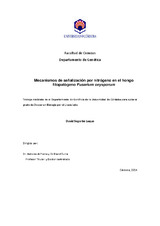Mostrar el registro sencillo del ítem
Mecanismos de señalización por nitrógeno en el hongo fitopatógeno Fusarium oxysporum
| dc.contributor.advisor | Di Pietro, Antonio | |
| dc.contributor.advisor | Turrà, David | |
| dc.contributor.author | Segorbe Luque, David | |
| dc.date.accessioned | 2015-02-06T10:16:04Z | |
| dc.date.available | 2015-02-06T10:16:04Z | |
| dc.date.issued | 2015 | |
| dc.identifier.uri | http://hdl.handle.net/10396/12556 | |
| dc.description.abstract | Las rutas de señalización MAP quinasa (MAPK) están presentes en todos los organismos eucariotas y controlan gran variedad de respuestas celulares a estímulos ambientales. Estudios previos han demostrado el papel fundamental de una MAPK, denominada Fmk1, en la virulencia del hongo patógeno del suelo Fusarium oxysporum. Sin embargo, no se conocen las señales que regulan la actividad de dicha ruta durante el proceso de infección, solo se han descrito dos receptores transmembrana, denominados Msb2 y Sho1, que regulan esta ruta. En el presente trabajo se ha caracterizado el mecanismo molecular que determina la regulación de la ruta MAPK Fmk1 por fuentes de nitrógeno. Se observó que el amonio ejerce un efecto represor sobre la actividad de la ruta y, por lo tanto, inhibe las funciones de virulencia de Fusarium. El efecto represor del amonio requiere su transporte a través de la proteína MepB, y conlleva una acidificación del medio. En una serie de experimentos de análisis “western blot” se demostró, que el pH ambiental actúa como un regulador maestro de la actividad de las tres rutas MAPK de F. oxysporum. Se observó, además, la interacción cruzada entre las distintas MAPKs. Se procedió a generar mutantes individuales y dobles en las tres rutas MAPK y se llevó a cabo una caracterización detallada de sus fenotipos relevando efectos sinérgicos entre las distintas rutas. | es_ES |
| dc.description.abstract | The MAP kinase signaling pathways (MAPK) are present in all eukaryotic organisms and control a variety of cellular responses to environmental stimuli. Previous studies have demonstrated the crucial role of MAPK, called Fmk1 in pathogen virulence soil fungus Fusarium oxysporum. However, the signals that regulate the activity of the infection pathway are not known, there are only described two transmembrane receptors, called Msb2 and Sho1, which ones regulate this route. In this study we have characterized the molecular mechanism that determines the regulation of MAPK pathway Fmk1 in respond for different nitrogen sources. Observed that ammonia has a repressive effect on the activity of the pathway and, therefore, inhibits the virulence functions of F. oxysporum. The repressor effect of ammonium requires transport through MepB protein, and leads to acidification of the medium. In a series of experiments of analysis "western blot" was shown, that the environmental pH acts as a master regulator of the activity of the three MAPK pathways in F. oxysporum . The cross-talk between different MAPKs were also observed. It was proceeded to generate single and double mutants in the three MAPK pathways and conducted a detailed characterization of their phenotypes relieving synergies between the different routes. | es_ES |
| dc.format.mimetype | application/pdf | es_ES |
| dc.language.iso | spa | es_ES |
| dc.publisher | Universidad de Córdoba, Servicio de Publicaciones | es_ES |
| dc.rights | https://creativecommons.org/licenses/by-nc-nd/4.0/ | es_ES |
| dc.subject | Organismos eucariotas | es_ES |
| dc.subject | Rutas de señalización MAP quinasas (MAPK) | es_ES |
| dc.subject | Fusarium oxysporum | es_ES |
| dc.subject | PH ambiental | es_ES |
| dc.subject | Ascomicetos | es_ES |
| dc.title | Mecanismos de señalización por nitrógeno en el hongo fitopatógeno Fusarium oxysporum | es_ES |
| dc.type | info:eu-repo/semantics/doctoralThesis | es_ES |
| dc.rights.accessRights | info:eu-repo/semantics/openAccess | es_ES |

